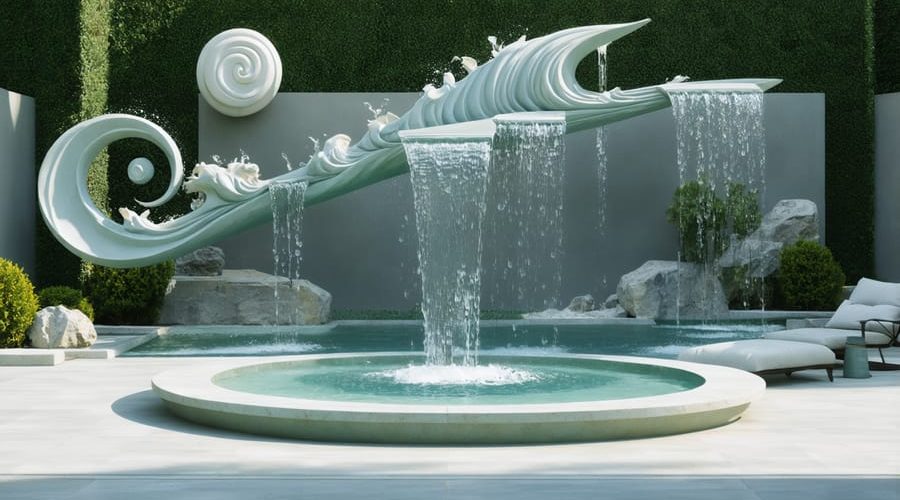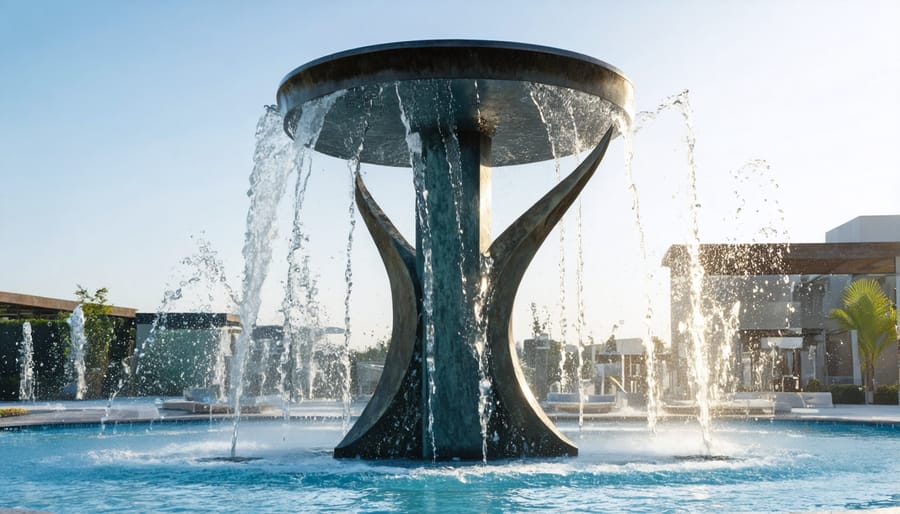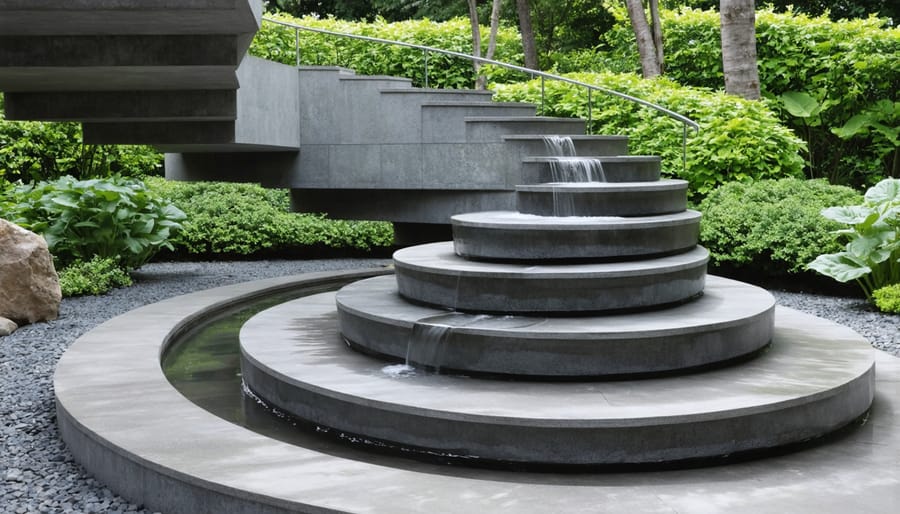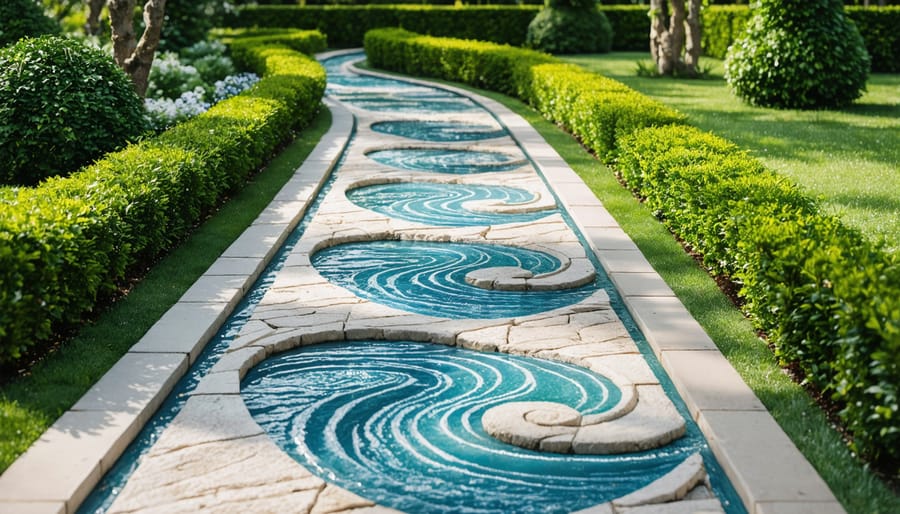
Ancient Greek Water Symbols Transform Modern Garden Design
Water symbols in ancient Greek culture hold a profound significance that continues to inspire modern water feature designs today. The trident of Poseidon, god of the seas, represents power and fluidity, while the spiral wave pattern symbolizes eternal movement and life’s continuous flow. These timeless symbols transform ordinary garden spaces into meaningful sanctuaries, connecting us to centuries of mythological wisdom and natural beauty.
For DIY enthusiasts and garden lovers, Greek water symbols offer more than just decorative elements – they provide a rich framework for creating spaces that feel both grounded and dynamic. Whether carved into stone features, incorporated into mosaic patterns, or expressed through flowing fountain designs, these ancient motifs bring classical elegance to contemporary outdoor spaces while celebrating water’s life-giving properties.
This practical fusion of historical symbolism with modern garden design allows homeowners to create spaces that are both personally meaningful and visually striking, turning everyday water features into conversation pieces that tell stories of ancient wisdom.
The Trident of Poseidon: Power and Movement
Creating Wave-Like Features
Creating wave-like features in your water garden brings ancient Greek symbolism to life while adding mesmerizing movement to your outdoor space. Start by incorporating curved edges in your pond design, mimicking the natural flow of water. Consider installing a serpentine stream that meanders through your garden, using different-sized rocks to create gentle rapids and mini-waterfalls.
For a more dramatic effect, try installing multiple cascade levels with curved spillways. These not only create the symbolic wave pattern but also produce soothing water sounds. Small, wave-shaped retaining walls around your pond can echo this theme while providing practical seating areas.
Plant selection plays a crucial role too. Choose ornamental grasses that sway in the breeze, creating a wave-like motion. Blue fescue and fountain grass are excellent choices. Position these plants in curved groupings along your pond’s edge to enhance the flowing effect.
For smaller spaces, consider adding wave-patterned tiles or mosaics near your water feature. Even simple ripple patterns created by strategically placed underwater lights can bring this ancient symbolism into your modern garden design.
Integrating Trident Motifs
The trident, with its three-pronged design, offers endless possibilities for creating eye-catching water features in your garden. For a stunning focal point, consider installing a wall-mounted fountain where water cascades down three parallel channels, mimicking the trident’s distinctive shape. You can achieve this effect using copper or stone materials for an authentic Greek feel.
Another popular approach is incorporating trident-shaped spouts in existing fountains. These can be arranged in circular patterns, creating a mesmerizing display as water streams converge in the basin below. For smaller spaces, try adding miniature trident ornaments around pond edges or positioning three reed fountains in a triangular arrangement.
DIY enthusiasts can craft simple trident motifs using bamboo pipes split into three sections. Position these at fountain outputs to create natural-looking water streams. For a modern twist, consider LED-lit trident sculptures that illuminate your water feature at night, combining ancient symbolism with contemporary design.
Remember to maintain proportion – the trident elements should complement, not overwhelm, your overall garden design. Start small with a single trident feature and expand based on your space and comfort level.

The Spiral: Ancient Symbol of Water Flow
Spiral Water Features
The spiral, a powerful symbol in Greek water mythology, can be beautifully incorporated into modern pond design basics to create mesmerizing water features. Drawing inspiration from ancient Greek representations of water movement, spiral patterns can be achieved through carefully placed rocks and flowing water paths that create a gentle, circular motion.
To implement this design, start by arranging stones in a decreasing spiral pattern from the outer edge toward the center. The water should flow from the highest point, following the natural curve of the spiral downward. This creates not only a visually striking feature but also produces a soothing sound as water cascades through the pattern.
Consider using different-sized rocks to create varying water speeds and sounds throughout the spiral. Small waterfalls can be incorporated at strategic points, enhancing the dynamic flow. LED lighting placed along the spiral path can dramatically highlight the water’s movement at night, creating an enchanting atmosphere that pays homage to the ancient Greek understanding of water’s spiritual nature.
For maintenance, ensure the pump is properly sized to maintain consistent flow throughout the spiral pattern. Regular cleaning will keep the water moving smoothly along its intended path.

Natural Flow Patterns
The ancient Greeks understood that water naturally flows in spirals and curves, a pattern we can recreate in modern water gardens. By incorporating these organic movements, you can create a more natural and harmonious space that captures the essence of Greek water symbolism.
Start by planning curved pathways around your water feature that mimic the spiral patterns found in nature. Consider placing rocks and plants strategically to guide water flow in gentle curves rather than straight lines. Small cascades can be arranged in a descending spiral pattern, creating both visual interest and soothing sounds.
For pond designs, think about incorporating a vortex pattern with plantings that sweep around the water’s edge. This creates a sense of movement even when the water is still. You can achieve this effect by placing taller plants at the outer edges and gradually decreasing height as you move inward.
Adding floating elements like water lilies helps emphasize these natural curves, as they tend to arrange themselves in circular patterns on the water’s surface. Remember, the goal is to create flow that feels effortless and organic, just as the Greeks observed in their natural waterways.
Greek Waves and Meanders
Border and Edging Designs
Transform your garden’s edges into stunning Greek-inspired designs by incorporating classic wave patterns. Start by sketching a simple wave pattern on paper, then transfer it to your garden border using marking paint or string. Create flowing curves that mimic the ancient Greek symbol for water, using different materials like stones, pavers, or plants.
For pond edges, arrange medium-sized rocks in an undulating pattern, alternating heights to create a natural wave effect. Plant blue-flowering varieties like lobelia or forget-me-nots between the rocks to enhance the water theme. Consider adding small water features or fountains at key points along the border to bring movement and sound to your design.
For garden pathways, lay pavers or stepping stones in a meandering pattern that suggests flowing water. Edge these paths with low-growing plants like creeping thyme or blue fescue grass to soften the lines. You can also incorporate mosaic tiles featuring wave patterns for an authentic Mediterranean touch.
Remember to maintain proper drainage when building these borders, especially near ponds. The wave pattern should not only be decorative but also functional, helping to direct water flow during heavy rains.
Water Path Design
Creating meandering water paths inspired by Greek symbolism can transform your garden into a serene oasis. Start by sketching a gentle, winding pattern that mimics the Greek wave symbol, known as the “meander” or “Greek key.” This classic design represents the eternal flow of water and life itself.
When planning your water channel, aim for curves that flow naturally through your landscape. Begin with a wider entry point that gradually narrows, creating a sense of movement and drawing the eye through the garden. Layer different-sized rocks along the edges, mixing smooth river stones with larger boulders to echo ancient Greek waterways.
Consider incorporating spiral patterns at key points where the water changes direction. These spirals, inspired by the Greek symbol for water vortexes, add visual interest and create gentle water sounds. For added authenticity, place small ceramic urns or vessels along the path, reminiscent of ancient Greek water carriers.
Make sure to include shallow areas where water can pool briefly before continuing its journey. These reflection points not only add visual depth but also provide practical benefits for wildlife and plant life, making your Greek-inspired water feature both beautiful and functional.

Modern Applications and DIY Ideas
Ancient Greek water symbols can bring both beauty and meaning to your modern garden space. Whether you’re creating new DIY water garden features or enhancing existing ones, incorporating these timeless elements adds a layer of sophistication and storytelling to your outdoor sanctuary.
Start with the classic wave pattern, or “Greek key,” which you can use as a border design around pond edges or water features. Create this using decorative tiles, painted stones, or even carefully arranged pebbles. For a simpler approach, consider stenciling the pattern onto garden pots or concrete surfaces near water features.
The trident symbol, associated with Poseidon, makes an eye-catching focal point when incorporated as a garden stake or fountain centerpiece. You can craft a simplified version using copper pipes or weather-resistant materials, positioning it as an artistic element rising from your pond or fountain.
Spiral patterns, representing the eternal flow of water, can be integrated through stepping stones leading to your water feature. Paint these ancient symbols on flat rocks using weather-resistant paint, or embed them in concrete pavers. For a more natural look, arrange small river rocks in spiral patterns around your pond’s edge.
Consider adding Greek-inspired water vessels, such as amphoras or urns, as fountain features. These can be found at garden centers or crafted from modern materials to mimic ancient designs. Position them to create gentle water flows, adding both visual interest and soothing sounds to your garden.
For vertical interest, install a wall fountain featuring the dolphin motif, a symbol often associated with water deities in Greek mythology. Modern interpretations can be created using contemporary materials while maintaining the classical essence of the design.
Remember to keep the overall design balanced and not overcrowded. Choose one or two symbolic elements as focal points rather than incorporating every Greek water symbol available. This approach ensures your garden maintains its serenity while celebrating these meaningful ancient designs.
The enduring legacy of Greek water symbols continues to inspire and shape modern garden design, offering a perfect blend of ancient wisdom and contemporary aesthetics. Whether it’s the spiral patterns representing the eternal flow of life, the wave motifs symbolizing constant change, or the trident embodying water’s raw power, these classical elements add depth and meaning to today’s water features.
For the modern gardener, incorporating these timeless symbols doesn’t require extensive knowledge of ancient Greek mythology. Simple additions like spiral-shaped fountains, wave-patterned tiles around pond edges, or trident-inspired water spouts can transform an ordinary water garden into a space that tells a story. These elements not only enhance visual appeal but also create meaningful connections to our shared cultural heritage.
As we continue to seek ways to bring tranquility and beauty to our outdoor spaces, Greek water symbols offer a rich source of inspiration that bridges past and present. Their universal themes of flow, renewal, and life-giving power remain as relevant today as they were thousands of years ago, making them perfect elements for creating thoughtful and engaging water features in contemporary gardens.
